The Best DOS Driving Games - Part 3
4th November 2023
In the third part of the best driving games on the DOS platform, we get to the period 1993 to 1995.
3D was firmly the only choice for driving games by this point, and we saw games starting to leverage the power of faster CPUs like the 486DX-33, its clock-doubled variants and the early Pentiums, and graphics cards that could make use of the wider 32-bit VESA Local Bus.
Here's the list of driving games we'll explore:
Part 3 - 1993-1995
|
Indycar Racing (Papyrus Design Group, 1993)
See also my dedicated game page for Indycar Racing.
Papyrus released their second racing game in 1993. Taking what they had learned from the excellent but somewhat limited Indianapolis 500, Indycar Racing was bigger and better in every way.
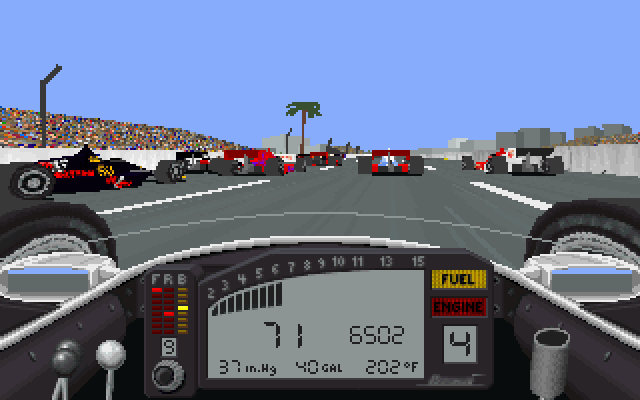 Based on the 1993 Indycar season, all the usual teams, cars and drivers are present. Initially, only 8 tracks were provided but 4 more were added shortly after once they had secured the rights to them, and an expansion pack was later released with a further 7 tracks, bringing the total up to 19.
Based on the 1993 Indycar season, all the usual teams, cars and drivers are present. Initially, only 8 tracks were provided but 4 more were added shortly after once they had secured the rights to them, and an expansion pack was later released with a further 7 tracks, bringing the total up to 19.
Papyrus had already built a reputation on their attention to detail, accuracy and authenticity, and Indycar Racing was no exception. Car setups were broadened further from what was achievable with Indianapolis 500, with a lovely graphical interface for the various component parts of the car including steering lock, camber and pressure for each tyre, front and rear wing, antiroll bar stiffness, braking bias, stagger, and shock stiffness. There's so much to this it can make your head spin - you will lose hours getting to what you think is the perfect setup for a given track.
 The amount of detail that was visible in the 3D car models also took a significant step forward with Indycar Racing, and because each 3D model was made up of more "surfaces", the damage model had more to work with. Individual portions of a car can appear damaged or become detached from the car completely, with all of the repercussions that might entail!
The amount of detail that was visible in the 3D car models also took a significant step forward with Indycar Racing, and because each 3D model was made up of more "surfaces", the damage model had more to work with. Individual portions of a car can appear damaged or become detached from the car completely, with all of the repercussions that might entail!
Track scenery was also well done, with many more buildings, advertising billboards, bridges and tunnels than existed previously.
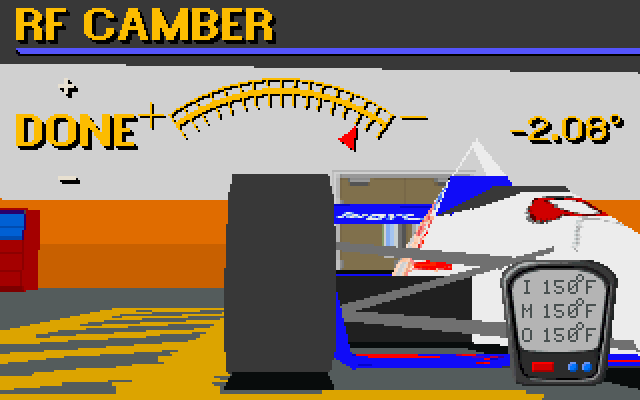 On the audio front, Indycar Racing came with good music and excellent authentic sound effects for each car's engine, crashes, and other raceway sounds. You can also hear multiple cars when they are close by. The game supported the MediaVision ProAudio Spectrum card, Ad Lib's Gold card, and Sound Blaster.
On the audio front, Indycar Racing came with good music and excellent authentic sound effects for each car's engine, crashes, and other raceway sounds. You can also hear multiple cars when they are close by. The game supported the MediaVision ProAudio Spectrum card, Ad Lib's Gold card, and Sound Blaster.
Indycar Racing ran only in 256-colour VGA graphics mode, and in the now standard 320 x 200 resolution. This gave you the best blend of retaining decent frame rates while offering good enough resolution.
Sound: Lovely engine sounds and the fact you hear as many other cars as there are within earshot really help immerse you in the sense you're in an Indycar. 8/10
Gameplay: Just excellent - I mentioned Papyrus' attention to detail, and this game has it in spades. The car feels and behaves as you might expect (without being a car handling and aerodynamics expert). With all the Indycar tracks faithfully reproduced here, and an accurate representation of an Indycar race from practic, qualifying (called 'Warm Up') to the actual race. Flags for key events are also in there, including rolling starts, and the pitlane. 8/10
Lastability: There's no track builder here, but that's not the point given the authenticity of the tracks provided - there's a ton of content in this sim to keep you occupied for many many hours - car setups are a key part of this! It's not an easy game but is true to its design goals as a proper racing simulator. 9/10
OVERALL: 8/10
Lotus: The Ultimate Challenge (Gremlin, 1993)
I mentioned in part 2 how Gremlin have a great track record of producing arcade racers, noting in particular the Lotus series which were developed by Magnetic Fields. As name implies, this is the third installment and it culminates all that was great about the first two titles, even though the first two sadly were not ported to DOS (I think this is why the DOS title is just Lotus: The Ultimate Challenge).
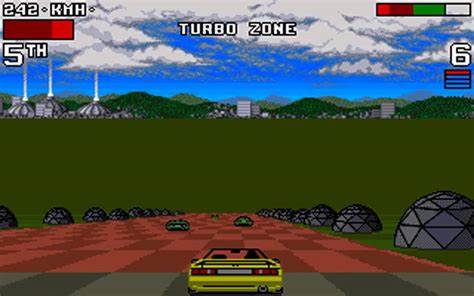 The game brought back the two-player split screen mode from the first Lotus game and also included the 'RECS' course designer that was introduced in the second. This isn't really a designer per-se, just a means of configuring your own settings like track type, landscape, weather, difficulty, number of obstructions, etc.
The game brought back the two-player split screen mode from the first Lotus game and also included the 'RECS' course designer that was introduced in the second. This isn't really a designer per-se, just a means of configuring your own settings like track type, landscape, weather, difficulty, number of obstructions, etc.
Race either against the clock or an opponent over numerous types of track including desert, mountain, windy, space(!), forest, and quite a few more. These can be laps around a circuit or point-to-point like a rally. You get to choose from three Lotus cars: the Esprit S4, Elan (which had the development code of M100), or the M200 prototype. Each race you complete opens up a code that you can write down and re-input later to jump to that race.
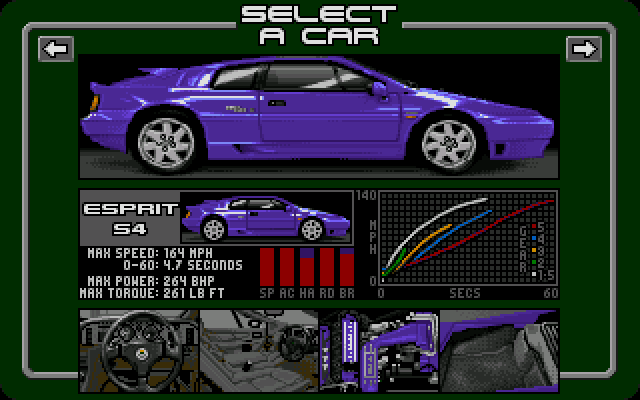 By 1993 though, this style of arcade racer was getting a little long in the tooth. The gameplay moves along at a good speed and the graphics are decent. Sound options include Ad Lib, Sound Blaster and Roland, though there is only music - no sound effects.
By 1993 though, this style of arcade racer was getting a little long in the tooth. The gameplay moves along at a good speed and the graphics are decent. Sound options include Ad Lib, Sound Blaster and Roland, though there is only music - no sound effects.
You can play with keyboard or joystick, and the controls work well enough. The real fun to be had with Lotus: The Ultimate Challenge is in the two-player split screen mode, and I'm very happy this option returned to the Lotus trilogy (I had previously enjoyed the first two games on the Commodore Amiga). The second Lotus game was criticised for this being removed, and the developers listened.
Sound: Ad Lib, Sound Blaster and Roland MT-32 are all supported and the music is excellent. You get choose from a variety of 'radio stations' for the in-game music, though there's no sound effects. 6/10
Gameplay: Really fun in two-player split screen mode, less so if you're just racing against the clock or other computer-controlled opponents. The game speed is excellent. 7/10
Lastability: With the RECS course designer, Lotus III's longevity is improved slightly, but really it's just more of the same. It's a decent game you can pick up and play for 20 minutes and come back to later. 5/10
OVERALL: 6/10
Network Q RAC Rally (Europress, 1993)
This is the spiritual sequel to Europress's earlier Lombard RAC Rally we looked at in Part 1, having switched developers from Red Rat to Pixelkraft for this one. It's also apparently the first game in their RAC Rally Championship series.
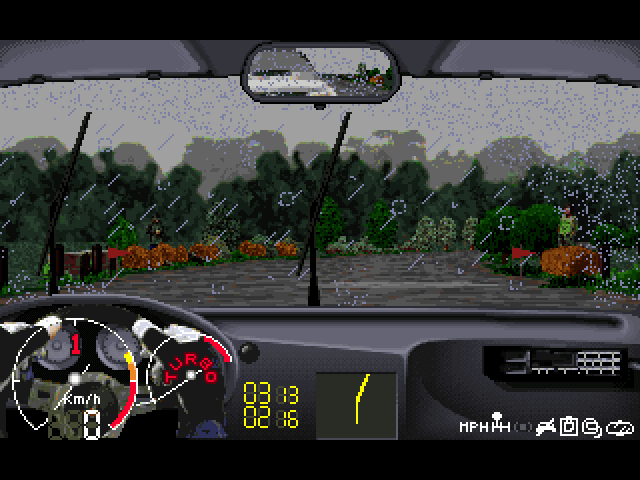 The intro sequence is nice, showing video footage of rally cars in action as the credits roll. Sound support covers PC speaker, Ad Lib, Sound Blaster, Disney Sound Source and ProAudio Spectrum 16.
The intro sequence is nice, showing video footage of rally cars in action as the credits roll. Sound support covers PC speaker, Ad Lib, Sound Blaster, Disney Sound Source and ProAudio Spectrum 16.
You can opt to drive one of five rally cars of the time: Toyota Celica GT4, Ford Escort RS Cosworth, Lancia Delta HF Integrale, Mitsubishi Lancer Evo and Subaru Impreza. For each stage you can check the weather and set appropriate tyres ranging from dry road, wet road, mud/forest and snow.
Just like in a real rally car, you get verbal directions of what's coming up by your navigator, such as "right one" or "road narrows", and this is incredibly valuable. The graphics are pretty decent and the weather effects like the rain and night driving really add to the atmosphere.
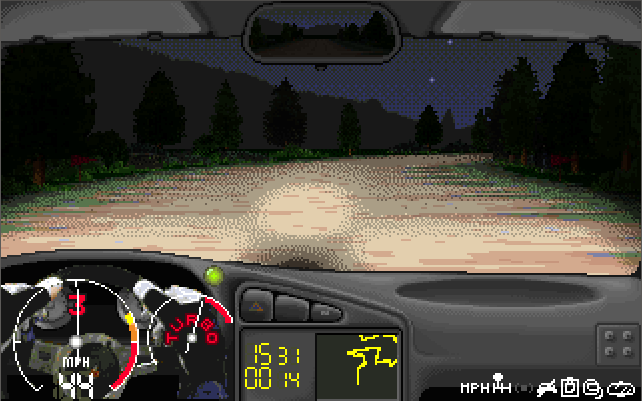 You will see other rally cars on the stage with you, since each car is released 30 seconds apart at the start line. This delay can be altered using a command-line argument (check the readme file).
You will see other rally cars on the stage with you, since each car is released 30 seconds apart at the start line. This delay can be altered using a command-line argument (check the readme file).
The game allows for up to 6 human players who take it in turns to drive each rally stage before everyone moves to the next segment. Each driver can select their own car and change their name if they choose. The computer will operate all the other cars that are taking part.
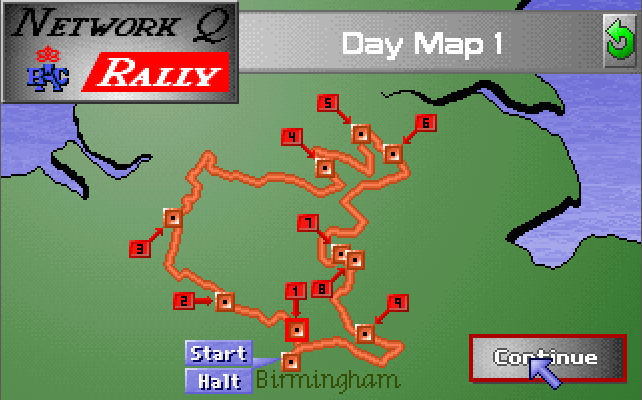 Controlling the car is best done with an analogue joystick, as I found playing with keyboard controls to be too 'digital' - you need that progressive steering that only an analogue joystick can provide. Even then, the car physics aren't particuarly complex and it feels pretty 'arcadey'. If you go for a manual gearbox there's a handy gear change light on your dash that lights up green if your revs are too low (indicating that you should change down) or red if your revs are too high (change up).
Controlling the car is best done with an analogue joystick, as I found playing with keyboard controls to be too 'digital' - you need that progressive steering that only an analogue joystick can provide. Even then, the car physics aren't particuarly complex and it feels pretty 'arcadey'. If you go for a manual gearbox there's a handy gear change light on your dash that lights up green if your revs are too low (indicating that you should change down) or red if your revs are too high (change up).
The game does require a pretty fast 486 or Pentium to get the best out of it. If you're running on a low-end 386 you can switch off weather effects on the windscreen, ground/road textures, and also disable any of the four sound channels independently using CTRL+F1 through F4 (the audio places a big burden on game speed).
The game does get a bit boring after a while, but there is good variation in the rally stages and with the weather and day/night featuring, this keeps things interesting for a while. It's a massive improvement on Lombard RAC Rally!
Sound: Decent music during the intro and menus, and good sound effects during driving - engines sound authentic, and let's not forget the navigator's speech - great job! 8/10
Gameplay: So much better than the earlier Lombard RAC Rally (that's what 4 years of PC advancement delivers). You get a great sense of speed in this game, and it can get tense at times, though the car physics aren't the best. If there's one or two criticisms I have, it's that there's no obvious drifting capability built into the physics engine, and there are no external views to help you understand the direction your car is facing compared to the direction of travel, 7/10
Lastability: You won't last too long playing this game - aside from the aforementioned different weather and day/night changes, it's a lot of the same. Still, a fairly decent attempt at a rally game. 5/10
OVERALL: 7/10
Nigel Mansell's World Championship Racing (Gremlin, 1993)
Another celebrity tie-in, this time for Nigel Mansell, who won the Formula One world championship in 1992. Gremlin got Astros Productions to develop this game, which is an odd choice after the complete and utter failure that Toyota Celica GT Rally was the year before. How will this one turn out? Let's see!
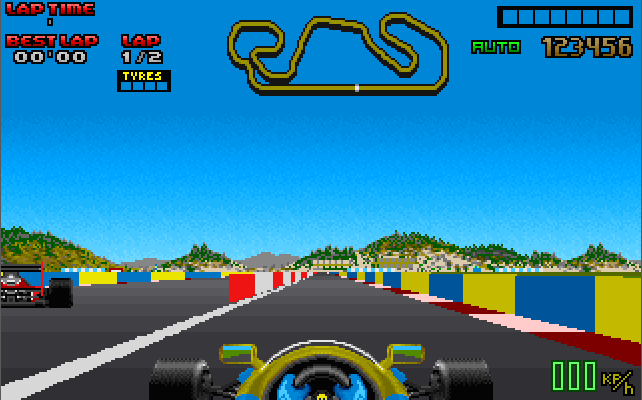 The game starts off ok, with some ok music and the menu system is functional, and all the teams are in there along with 16 Formula One racing circuits.
The game starts off ok, with some ok music and the menu system is functional, and all the teams are in there along with 16 Formula One racing circuits.
There's also several choices apart from taking part in the World Championship season. There's a practice mode for you to try out any circuit and get to know it, and also an 'Improve with Mansell' option where you're given textual guidance from Mansell as you navigate the track. This is more a novelty than serious queues on your driving style.
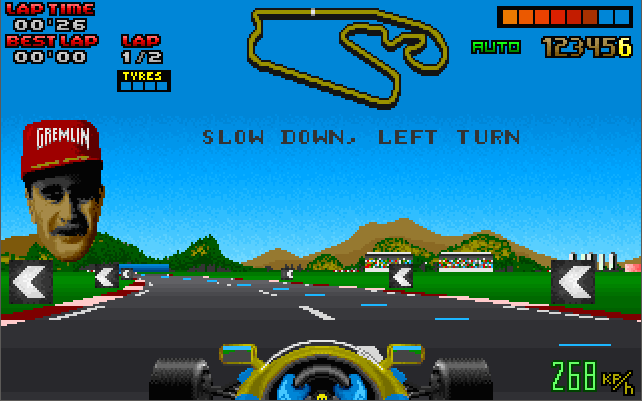 Sadly as soon as you get behind the wheel it all goes wrong. Steering is sluggish, acceleration takes an age to get up there and then behaves like a rocket. Cornering is unrealistic, being far too easy to take a turn at speeds that would have you off in the gravel. Basically the entire physics engine is shot in this game. There's little to redeem it, especially after we've already had the amazing Indycar Racing released this year.
Sadly as soon as you get behind the wheel it all goes wrong. Steering is sluggish, acceleration takes an age to get up there and then behaves like a rocket. Cornering is unrealistic, being far too easy to take a turn at speeds that would have you off in the gravel. Basically the entire physics engine is shot in this game. There's little to redeem it, especially after we've already had the amazing Indycar Racing released this year.
The graphics are not 3D objects, so this is more akin to Grand Prix Circuit (a great game for its time, btw), and that's fine if it's what the game is supposed to be. Is it an arcade racer or is it trying to be a sim? I'm not sure which - all I can tell you is that as an arcade game it's just not fun because of the sluggish controls I mentioned, and if it's a sim it's an epic failure due to the poor physics.
I feel sorry for Nigel Mansell stamping his name on this game, as he was a top-flight F1 driver (up there with Ayrton Senna and Alain Prost) - what a shame.
Sound: Decent music but oh dear, those sound effects... it's like the sound guy had a bad head cold and couldn't hear a thing when writing the code for the engine sound. 2/10
Gameplay: Just awful. I can accept roughly-drawn graphics in any game as long as the gameplay is up there - here it isn't. Beyond the nice enough menus and options to setup your car, this game is badly let down by a poor unresponsive control system and even poorer car physics. 2/10
Lastability: You won't last long with this game. In fact, if you bought it, chances are you went immediately back to the shop to get a refund. 2/10
OVERALL: 2/10
Formula One (Domark , 1994)
Don't expect this to be competing against Microprose's Formula One Grand Prix - this game from Domark is a fun F1 arcade racer, not a simulator. The game comes across as nicely polished with great in-menu music and good enough 256-colour VGA graphics, though selecting what you want isn't at all obvious unless you read the manual (more on that in a bit).
 At a high level, you have the choice of 'Arcade', 'Training' or 'Championship'. For each of these there are four skill levels: Novice, Amateur, Professional, and Expert.
At a high level, you have the choice of 'Arcade', 'Training' or 'Championship'. For each of these there are four skill levels: Novice, Amateur, Professional, and Expert.
In Arcade mode, you race on a single circuit, Interlagos in Brazil. It's the quickest way to get behind the wheel for a short blat. Before starting the race you have the option of 1 Player or 1 Player Turbo. The 'Turbo' option here puts the game into a lower resolution (160 x 200?) so it runs super-fast! The non-turbo option is in 320 x 200 and runs slightly more pedestrian. You also get the option to select your wing height for more downforce (making your car slower but with better traction or faster with less traction), manual or automatic transmission, and the tyre compound. You're then into the race.
The second mode is 'Training' - this allows you to choose a selection of 12 tracks to race on, and who to race against. This is where the real fun comes in, as in addition to the standard 1 Player and 1 Player Turbo options, you can opt for a two-player split screen mode, either against another human or against the computer.  I'm not 100% sure if you can see each other as you drive around - I couldn't, and this is a bit of a shame, making it still feel like you are both driving against the clock and for the highest position in reality.
I'm not 100% sure if you can see each other as you drive around - I couldn't, and this is a bit of a shame, making it still feel like you are both driving against the clock and for the highest position in reality.
The third and final mode is 'Championship' where you select the tracks that will make up the season, and then for each you go through a round of qualifying to determine where you start on the grid, then it's off to the race!
Pitting involves you pulling into the pit lane and stopping, then you use F1 to select what to change (tyres only in a race, but downforce or auto/manual box options are also available in qualifying rounds) and F2 to change that item. When you're done, I believe it's holding down Right-CTRL to actually make the adjustments and when the red bar is complete you can drive off.
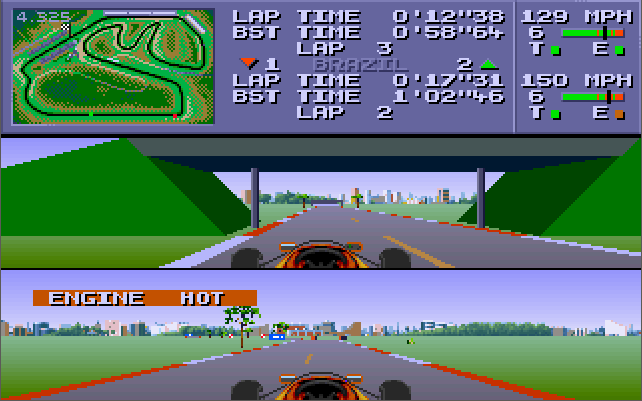 The gameplay is very arcade-like, with a bit too much steering help for my liking. You tend to floor the accelerator most of the time you're driving, regardless of how harsh upcoming corners might be.
The gameplay is very arcade-like, with a bit too much steering help for my liking. You tend to floor the accelerator most of the time you're driving, regardless of how harsh upcoming corners might be.
As mentioned, the menu selection mechanism isn't obvious. When you are presented with a list of tracks you need to actually add them from the left side of the screen to the right by using the arrow keys to highlight a track and pressing ALT. You cannot undo any that you add, which is a pain.
 Still, it's still a great fun racer, and with some little added complexities such as pitting to change tyres and repair an overheating engine it's more than just a start-to-finish race.
Still, it's still a great fun racer, and with some little added complexities such as pitting to change tyres and repair an overheating engine it's more than just a start-to-finish race.
Racing the computer-controlled drivers isn't as easy as it looks. You can catch up to those that overtake you with relative ease if they're slower but to win a race in this game is tougher. I crashed a lot into the pylons, hills and tunnel sides! Crashing doesn't tend to put you out of the race - your car is just picked up and slid back onto the track.
In summary, the whole thing still feels a bit basic and clunky. The scenery options are sparse and as I said before the controls are too simplistic. The 3D cars and other models aren't particuarly detailed either. All of this adds up to a game that misses the sweet spot between fun arcade racer and driving sim. This is another title that will run on fairly rudimentary PC hardware if that's all you have, but on a premium PC you'll likely find it lacking in the graphical fidelity you want and basic gameplay.
Sound: Great music but like some of the other games here the sound effects for the engine in Ad Lib or Sound Blaster mode are a bit of a disappointment. 6/10
Gameplay: The two-player split screen option is the winner here, and really adds to the value of this title. Racing in a full championship is less worth it, given that this game is more a 'pick up and play for 15 minutes' type affair than one that you'd dedicate hours on end playing. As I mentioned, the cornering assist (which you can't switch off) is a little too good for my liking, but I guess that was a design decision to keep it arcade-like. 7/10
Lastability: It's a game you'll likely come back to time and time again, and not for the broad selection of circuits to drive around, but for the two-player split-screen to compete against a friend. 7/10
OVERALL: 7/10
NASCAR Racing (Papyrus, 1994)
See also my dedicated game page for NASCAR Racing.
Just when you thought they couldn't improve any more, Papyrus Design Group brought out their third racing title, NASCAR Racing in 1994.
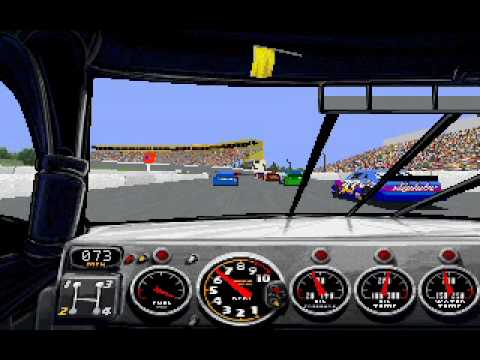 In almost every way, NASCAR Racing was just the same as Indycar Racing except you race in closed-cockpit saloon cars instead of open-wheeled cars.
In almost every way, NASCAR Racing was just the same as Indycar Racing except you race in closed-cockpit saloon cars instead of open-wheeled cars.
The major technological improvement with NASCAR Racing was that it could run in either 320 x 200 or in 640 x 480 resolution if you had bought the CD-ROM version and if your machine could handle it. This put the game at the pinnacle of 3D track racing in 1994, separating it from Microprose's Formula One Grand Prix, and even it's slightly older sibling, Indycar Racing.
 The same technical depth we'd come to expect after Indycar Racing was present in this title, with as many car setup options as you could think of: tyres pressures and stagger, fuel amount, front and rear spoilers, suspension, wheel lock, shock stiffness, and weight jacking.
The same technical depth we'd come to expect after Indycar Racing was present in this title, with as many car setup options as you could think of: tyres pressures and stagger, fuel amount, front and rear spoilers, suspension, wheel lock, shock stiffness, and weight jacking.
You can practice any of the tracks included in the game (of which there are nine) before proceeding to Qualify, Warm Up, and finally Race. Other computer-controlled cars will be out on the track doing the same as you during these pre-race sessions, which is authentic. Marshall flags must be obeyed so watch out for them!
The game's audio engine was extended over what was offered in Indycar to support 10 different sound cards for digital audio: Ad Lib Gold, Sound Blaster, Sound Blaster 16, Ensoniq Soundscape, ESS Audiodrive, Gravis UltraSound and UltraSound Max, MediaVision ProAudio Spectrum, and Roland RAP-10. Sound Blaster AWE32, Standard OPL3, GUS, General MIDI and Sound Master II were options for music.
The instant replay built into the game was full-featured, with the option to save and load them for later playback - very nice! Numerous camera angles were available to capture the action from certain vantage points including In-car, TV1, TV2, Rear Bumper, Front Bumper, Roof, Car Side, Driver Side, Chase, Rear Chase, Sky and Blimp.
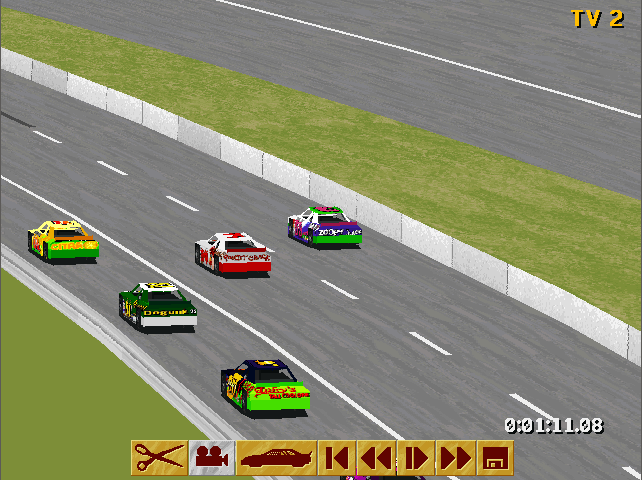 It did require a fast PC if you wanted decent frame rates, though the game was also bundled with some 3D video accelerator graphics cards at the time and using hardware acceleration transformed the frames per second you could expect.
It did require a fast PC if you wanted decent frame rates, though the game was also bundled with some 3D video accelerator graphics cards at the time and using hardware acceleration transformed the frames per second you could expect.
The graphics quality was second to none in 1994. With highly-detailed 3D cars that catered to your appetite for realism and having amazing crashes, decent track scenery, textures on the road surface, NASCAR Racing was a beautiful thing. Its authentic engine sounds and a bit of speech when the game first starts added to the opinion that this was a highly professional title from start to finish.
Sound: Great music and sound effects across the board. Plenty of sound card options that will suit almost everyone with a PC.9/10
Gameplay: We've come to expect top-of-class physics from Papyrus, and NASCAR is another example of a simulation done right. The cars are weighty, yet fully controllable. With 9 tracks in the standard game and the full array of driving sessions that lead up to the main race, there is plenty to do here, and I haven't even started on the car setup which is as full-featured as in Indycar Racing but also adds custom paint jobs! If NASCAR is a sport you follow, this is a must-have game. 10/10
Lastability: NASCAR Racing not only has single race and pre-season testing options, but the full Championship Season. If that weren't enough, play against other human drivers using the Multiplayer mode that allows you to connect with a modem. 10/10
OVERALL: 10/10
The Need For Speed (Electronic Arts, 1995)
Most gamers have heard of the Need for Speed series, as over the years it's had a presence on nearly every games console produced. It all started here though, with this title that came out in 1994 on the 3DO console and was ported to DOS a year after.
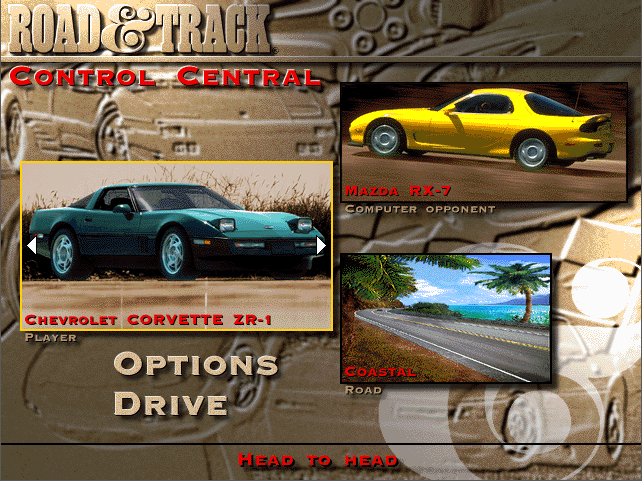 Sponsored by Road & Track magazine, the game came across as an arcade racer similar to Ridge Racer or Electronic Arts' own Road Rash, but the car physics model belied this assumption with fairly unique and detailed control for each car. NFS came with eight high-performance cars to choose from: Toyota Supra Turbo, Lamborghini Diablo VT, Mazda RX-7, Acura NSX, Porsche 911 Carrera, Chevrolet Corvette ZR-1, Dodge Viper RT/10 and Ferrari 512TR.
Sponsored by Road & Track magazine, the game came across as an arcade racer similar to Ridge Racer or Electronic Arts' own Road Rash, but the car physics model belied this assumption with fairly unique and detailed control for each car. NFS came with eight high-performance cars to choose from: Toyota Supra Turbo, Lamborghini Diablo VT, Mazda RX-7, Acura NSX, Porsche 911 Carrera, Chevrolet Corvette ZR-1, Dodge Viper RT/10 and Ferrari 512TR.
A total of six tracks came with the original: Rusty Springs Raceway, Autumn Valley Speedway, Vertigo Ridge, City, Coastal, and Alpine. Three of these are 'open road', three are closed circuits and one is a bonus track that's unlocked later. You can race on these in a number of game modes: Head-to-head, Single Race, Tournament and Time Trial. In the first two, you race against a single computer opponent or another human player over modem connection. In Tournament you take part in all the tracks, competing against 7 computer-controlled cars. Depending on the car you choose, you are put into Tournament Class A, B or C, so you complete against similar-specced cars. You must complete every track in 1st place to progress. The Time Trial is just as it sounds: a race against the clock to get the fastest time with no cops or other traffic to get in your way.
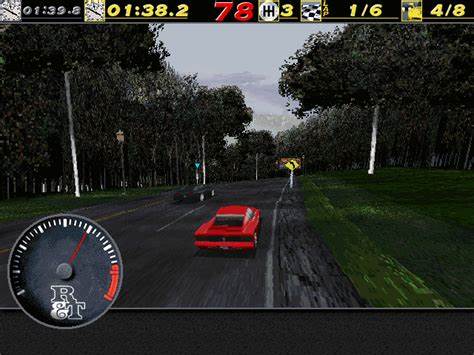 If you're playing in Head to Head mode on one of the open road courses like 'Coastal', cops play a crucial role - your car is fitted with a radar detector to tell you how close they are, and if you're speeding (why aren't you?) they will give chase. These open road courses are also nice as you get general traffic on the roads to avoid also.
If you're playing in Head to Head mode on one of the open road courses like 'Coastal', cops play a crucial role - your car is fitted with a radar detector to tell you how close they are, and if you're speeding (why aren't you?) they will give chase. These open road courses are also nice as you get general traffic on the roads to avoid also.
The Need for Speed is a tough game to win, and will require some patience and practice to learn the courses and the difficulty of your opponents. Just as with some other games here, the computer-controlled vehicles seem to recover from a crash so much quicker than you can.
The in-game graphics are gorgeous (up there with NASCAR Racing), and it can run in either 320 x 200 or 640 x 480 resolution, all in beautiful 256 colours. Numerous options exist to help the game run on slower hardware, all accessible from the Options menu and some, like the window size, image quality, horizon on/off and view distance can be changed during the gameplay itself - nice.
 Joystick options were plentiful and demonstrate the aim of this title being a serious racer, with support for the top-class joysticks of the time from CH Products, Thrustmaster and the like.
Joystick options were plentiful and demonstrate the aim of this title being a serious racer, with support for the top-class joysticks of the time from CH Products, Thrustmaster and the like.
The main menu is somewhat frustrating, as you need to go into the Options to change the game mode - this would have been better placed on the main menu alongside the car and track selections. Aside from this, it's nicely-presented with lots of photographic images, car specifications, and a video and history of each car. Some cars have ABS and Traction Control and if these are available you can set them on or off - nice one!
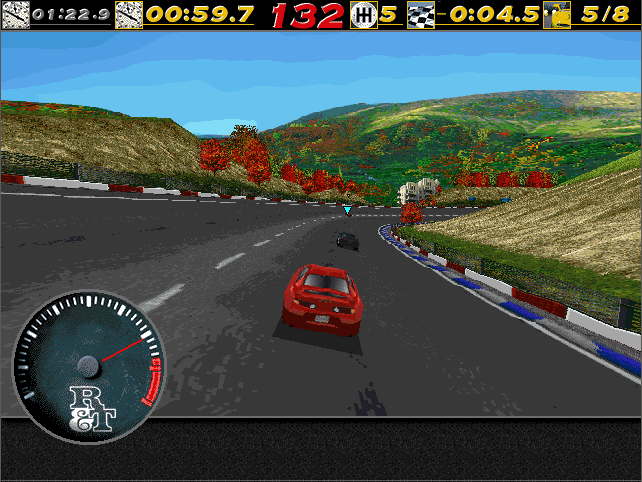 The replay mode in The Need for Speed is great, with five different camera angles to choose from - you even have the choice of just viewing a short clip of the key moments of your last race via the Highlight Reel. By default, the replay jumps to just the last 10 seconds of gameplay but you can go right back to the start if you wish. Replays can be saved to disk for later playback.
The replay mode in The Need for Speed is great, with five different camera angles to choose from - you even have the choice of just viewing a short clip of the key moments of your last race via the Highlight Reel. By default, the replay jumps to just the last 10 seconds of gameplay but you can go right back to the start if you wish. Replays can be saved to disk for later playback.
In 1996, a Windows version was released called The Need for Speed: Special Edition. This was technically very similar to the original, but was enhanced to run on DirectX 2.0 and added two more tracks: Transtropolis and Burnt Sienna.
Sound: Great pumping soundtrack and accurate car sound effects that are apparently digitally sampled from the actual vehicles - great job EOA! 9/10
Gameplay: With a decent number of high-performance sports cars to choose from, and tracks of different types and difficulties, NFS has a lot to offer. The game modes are all there, plus you get to race on roads with other traffic and cops, like in Test Drive 1 and 2! Given that it's a Road & Track-sponsored title, the additional footage, spoken descriptions of the cars technical abilities/mechanicals and an intro to the track give this game a polish that is lacking in others. I found NFS a really tough game - there's no difficulty level you can choose, so I guess the idea is to race using slower cars on easier tracks first, and graduate up when you feel ready. 9/10
Lastability: It would have been nice to see some car or track expansion packs produced, as you will eventually wear out what's in the game. Having the option to play against other human players with a modem will keep things interesting once you're done with the computer-controlled cars. 8/10
OVERALL: 9/10
Destruction Derby (Psygnosis, 1995)
 Who doesn't like crashing cars (in a game of course)? Go on, admit it, you drove the Indy 500 backwards didn't you...
Who doesn't like crashing cars (in a game of course)? Go on, admit it, you drove the Indy 500 backwards didn't you...
Destruction Derby is designed to scratch that itch. Developed by Reflections Interactive and released by Psygnosis in October 1995, you take control of a destruction derby car with the aim of being the last car running.
There are several game types including circuit racing which also awards you points for hitting your opponents in addition to finishing first, head-to-head with you against a single competitor, and the main destruction derby arena (called "the bowl") with up to 15 other cars.
 In the two race modes (called 'Wreckin' Racing' and 'Stock Car Racing'), you can choose from six tracks: Speedway, Cross-Over, Ocean Drive, Cactus Creek, or City Heat. With Wreckin' Racing you get points for destroying the other cars whereas Stock Car Racing is the more traditional goal to cross the finish line first. You get 50 points for 1st place, 40 for 2nd, 35 for 3rd, 30 for 4th, etc.
In the two race modes (called 'Wreckin' Racing' and 'Stock Car Racing'), you can choose from six tracks: Speedway, Cross-Over, Ocean Drive, Cactus Creek, or City Heat. With Wreckin' Racing you get points for destroying the other cars whereas Stock Car Racing is the more traditional goal to cross the finish line first. You get 50 points for 1st place, 40 for 2nd, 35 for 3rd, 30 for 4th, etc.
In Wreckin' Racing, you race 10 or 12 laps around the chosen track. You get 10 points for destroying another car or for spinning them 360 degrees, 4 points for spinning them round 180 degrees, and 2 points for just 90 degrees. These points are doubled if they occur with the driver currently in 1st place. There's a maximum of 99 points you can earn in a single round.
 The head-to-head mode has you in a vehicle chosen by the computer. There's also a multi-player mode which supports up to 16 human drivers who can take it in turns to play against the computer-controlled drivers. You can also form 'Team Pairs' where each human player works alongside some computer cars in teams that compete against each other. After everyone has had their turn, the scores for each driver are shown. In 'Tag' mode, all computer drivers target either you or another human player, and in 'Seek and Destroy' seven computer drivers go for you and your friend, and when someone gets tagged they forget about you and go for other human drivers, so the goal here is to ram as many computer cars as you can!
The head-to-head mode has you in a vehicle chosen by the computer. There's also a multi-player mode which supports up to 16 human drivers who can take it in turns to play against the computer-controlled drivers. You can also form 'Team Pairs' where each human player works alongside some computer cars in teams that compete against each other. After everyone has had their turn, the scores for each driver are shown. In 'Tag' mode, all computer drivers target either you or another human player, and in 'Seek and Destroy' seven computer drivers go for you and your friend, and when someone gets tagged they forget about you and go for other human drivers, so the goal here is to ram as many computer cars as you can!
 The real fun to be had is in the bowl - here there are several modes including 'Total Destruction' where you have to ensure your are the only one able to still move. There is a little pic of your car in the lower-right corner indicating the damage you have incurred at each corner and left and right side, and these go from green (no damage) up to red/pink (indicating major damage). Taking damage affects the handling of your such as not being able to turn as well in one direction, and difficulty in keeping your speed up. If you're hit too much in the front your radiator will blow and you're out of the competition.
The real fun to be had is in the bowl - here there are several modes including 'Total Destruction' where you have to ensure your are the only one able to still move. There is a little pic of your car in the lower-right corner indicating the damage you have incurred at each corner and left and right side, and these go from green (no damage) up to red/pink (indicating major damage). Taking damage affects the handling of your such as not being able to turn as well in one direction, and difficulty in keeping your speed up. If you're hit too much in the front your radiator will blow and you're out of the competition.
There is a commentator who frequently provides you with remarks about things you're doing, whether you've taken damage from someone else, or you've managed to get a '360' after hitting another vehicle. This really adds to the sense you're in a battle arena with spectators watching the action.
 The 3D models of the cars are nicely detailed, as is all the surrounding scenery. The standard game runs in a resolution of 320 x 200, though a special version was bundled with the Diamond Stealth 3D 2000 graphics card in April 1996 and ran with hardware acceleration, an upscaled resolution of 512 x 384 and with more object texturing. This version will also probably work with other S3 ViRGE-based graphics cards. At 320 x 200, it does appear very blocky by today's standards but in 1994 it was perfectly normal. If there's one complaint I have, it's that when cars are damaged you get a splintering effect during the crash but any parts that should fall off don't. Perhaps I'm being too picky but it would have been nice to have bits of the cars remain on the ground and act as further obstructions.
The 3D models of the cars are nicely detailed, as is all the surrounding scenery. The standard game runs in a resolution of 320 x 200, though a special version was bundled with the Diamond Stealth 3D 2000 graphics card in April 1996 and ran with hardware acceleration, an upscaled resolution of 512 x 384 and with more object texturing. This version will also probably work with other S3 ViRGE-based graphics cards. At 320 x 200, it does appear very blocky by today's standards but in 1994 it was perfectly normal. If there's one complaint I have, it's that when cars are damaged you get a splintering effect during the crash but any parts that should fall off don't. Perhaps I'm being too picky but it would have been nice to have bits of the cars remain on the ground and act as further obstructions.
Replays are done nicely with a variety of camera views, and you can even position your own floating camera and record your own replay before saving it to disk.
The driving physics don't give you a great deal of control of the car - just the usual steer, accelerate and brake, plus a 'fast corner' button [which I'm not sure what it does - handbrake perhaps?].
Sound: Brilliant commentating enhances the action and the engine sounds are great. Shame there's no music. 7/10
Gameplay: This is where the game sings - the smashing up of cars is the main point regardless of the game mode you choose, and with various views as you drive and the ability to replay the events in full plus the fact you can create your own replays with floating cameras is a nice touch. 7/10
Lastability: With such a broad variety of game types from racing and time trials to destruction as the end goal, there's a lot to keep you entertained here. Plus there's the multiplayer and team-based games too. 8/10
OVERALL: 8/10
Hi-Octane (Electronic Arts, 1995)
This is the first 'combat' racing game in my review, so it's a little different to what we've seen before. Developed by the excellent team at Bullfrog Productions and arriving in August 1995, it apparently used the game code from their earlier Magic Carpet game (according to Wikipedia). This is very apparent once you get into the game. I never owned Hi-Octane back in the 90s, and since this is my first go, please go easy if you disagree with my comments here.
 The game comes with six futuristic tracks of varying difficulty, and you race from 5 to 11 laps depending on which one you select. You can choose to take part in a single race or enter into the Championship which takes you through all the tracks in succession, keeping a leaderboard of your points as you progress.
The game comes with six futuristic tracks of varying difficulty, and you race from 5 to 11 laps depending on which one you select. You can choose to take part in a single race or enter into the Championship which takes you through all the tracks in succession, keeping a leaderboard of your points as you progress.
There are six vehicles in the game, and each one is rated by its speed, armour, weight, and firepower. Some are fast but are lacking in armour or weapons loadout. Others are slow and heavy but are built like a tank. You cannot change your vehicle between races in the Championship mode so there's no strategy to choose the right vehicle for each track.
There are three difficulty levels, which affect the AI drivers capabilities.
 In a race, the top of the screen shows levels for your speed, turbo, weaponry, and fuel - they're not marked so it's worth reading the manual to understand what's each of them are showing.
In a race, the top of the screen shows levels for your speed, turbo, weaponry, and fuel - they're not marked so it's worth reading the manual to understand what's each of them are showing.
The sound card options are plentiful: for music there's Ad Lib, Generic Yamaha OPL3, Tandy 3-voice, ESS ES688, Ad Lib Gold, Sound Blaster/Pro/16/AWE32, Ensoniq Soundscape, Gravis Ultrasound, ProAudio Spectrum/Plus/16, Roland MT-32 and General MIDI. For sound effects there's ESS ES688, Sound Blaster/Pro/16/AWE32, Ensoniq Soundscape, Roland RAP-10, ProAudio Spectrum, Gravis Ultrasound, and WaveJammer.
 For slower PCs, you can select a number of options while in the menu including Shading on/off, Sky on/off, five levels of texture mapping, and a choice of either 320 x 200 or 640 x 480, both in 256 colours. These will all help to ensure you are able to play the game on a variety of PC hardware.
For slower PCs, you can select a number of options while in the menu including Shading on/off, Sky on/off, five levels of texture mapping, and a choice of either 320 x 200 or 640 x 480, both in 256 colours. These will all help to ensure you are able to play the game on a variety of PC hardware.
Bullfrog's usual polish is present here, with lovely 256-colour graphics for the tracks and you do get a sense you're in the future, whether it's navigating distopian city streets or flying through a canyon. The speed of gameplay is at times frantic and at other times almost eerily quiet (maybe that's because I'm usually at the rear of the pack!). The controls are good enough, and while the game won't let you go very far off the track edges, you can turn a full 360 degrees if you missed a crucial item you wanted to pick up.
 Despite all the nice graphics, I feel the game is let down in a number of areas. The first, and probably most important is an intangible sense you're not really in full control of what's going on - you fire your weapons and you see explosions in the distance, but you don't actually see your weapon really firing in all the chaos - was it my missile that met its target or another player's? There are no crosshairs so you have to just put an opposing vehicle in the centre of the screen and hope for the best. Secondly, it's the same problem that plagued Magic Carpet - the draw distance. Gouraud shading is all very fancy 'n all, but for a game like this that relies on a bit of notice to know what's coming up, the fact you can't see off into the distance until sometimes it's too late is frustrating.
Despite all the nice graphics, I feel the game is let down in a number of areas. The first, and probably most important is an intangible sense you're not really in full control of what's going on - you fire your weapons and you see explosions in the distance, but you don't actually see your weapon really firing in all the chaos - was it my missile that met its target or another player's? There are no crosshairs so you have to just put an opposing vehicle in the centre of the screen and hope for the best. Secondly, it's the same problem that plagued Magic Carpet - the draw distance. Gouraud shading is all very fancy 'n all, but for a game like this that relies on a bit of notice to know what's coming up, the fact you can't see off into the distance until sometimes it's too late is frustrating.
Overall, I was a bit confused as to whether it's best to try and out-run my opponents who were shooting at me or slow down, let them overtake and then fire back (gaining me the next position up). You are scored according to where you finish in the race, so letting others overtake seemed illogical, but if you don't they will destroy your craft pretty quickly.
Three more tracks are available on the version 1.2 patch.
The visuals really are top-notch in Hi-Octane, aside from the limited draw distance - the tracks vary in their location and all are presented very well. Sadly though, for me, I felt too detached from the gameplay and this led to just getting bored rather quickly.
Sound: Excellent sound card support, great music that resonates with the feel and pace of the game and decent sound effects. 7/10
Gameplay: Gameplay is a mixed bag. As I've mentioned, it just seems to be missing something I can't quite put my finger on. Maybe I'm just getting old, but firing your weapons isn't always obvious where they're going, the lack of text in all the coloured status bars at the top seems like a miss (why should you need to read the manual to work out what's what on an arcade racer like this?). Most other reviews compare this game to Wipeout given their almost identical remit, though Wipeout takes the crown over this. 7/10
Lastability: Hi-Octane is still a fun racer/blaster - it has a good enough range of vehicles and tracks to keep you occupied, and if that weren't enough the patched version allows for multi-player.8/10
OVERALL: 7.5/10
Indycar Racing 2 (Papyrus, 1995)
See also my dedicated game page for Indycar Racing 2.
Papyrus Design Group seemed unstoppable in the driving simulator genre in the mid-90s. The follow-up to the excellent IndyCar Racing arrived in 1995, leveraging the advancements they had put into NASCAR Racing the year before, such as being able to run in the higher resolution of 640 x 480 in 256 colours. Just as Papyrus has done with NASCAR Racing, they made an agreement with the graphics card company Rendition, to produce a special hardware-accelerated version of the game for card manufacturers that used the Verite 1000 chipset. This gave the game a decent speed bump up to 30 frames per second.
 This time around the game focussed on the 1995 IndyCar race season with 15 tracks included along with real driver and team names, as well as period-correct advertising on the vehicles and around the racing circuits. You can race against up to 31 other drivers in either a single race or the full championship. Each race takes you through a practice session, warm-up, and then the race itself.
This time around the game focussed on the 1995 IndyCar race season with 15 tracks included along with real driver and team names, as well as period-correct advertising on the vehicles and around the racing circuits. You can race against up to 31 other drivers in either a single race or the full championship. Each race takes you through a practice session, warm-up, and then the race itself.
Your car's setup is critical to being successful in this game, so it's worth reading the manual cover to cover to understand what the effect of each setting does so you can tweak it for each circuit.
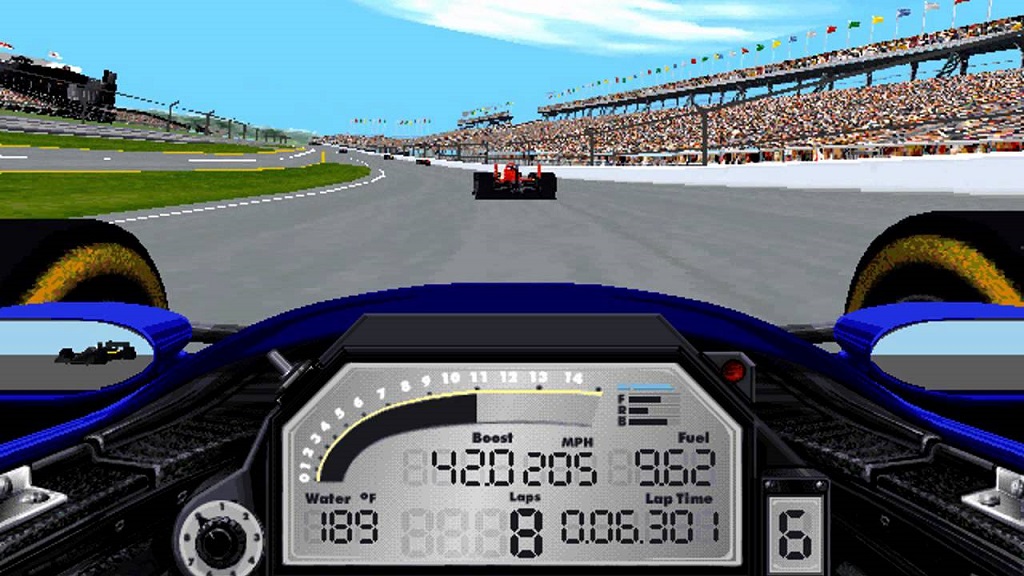 The physics of your car are done really well, so don't blame the game if you crash or spin - just change your setup and practice, practice, practice. The AI of the computer opponents isn't the best - they are a little too robotic for my liking, though this has been improved upon compared to Indycar Racing.
The physics of your car are done really well, so don't blame the game if you crash or spin - just change your setup and practice, practice, practice. The AI of the computer opponents isn't the best - they are a little too robotic for my liking, though this has been improved upon compared to Indycar Racing.
You can also opt for random weather which adds a touch of realism to a championship season.
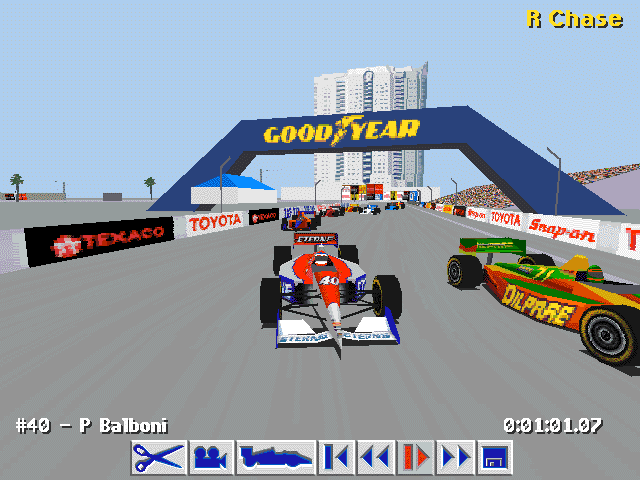 Running the game in 640 x 480 by using the '-h' command-line argument really helps distinguish ICR2 from the 1993 original, adding a lot of detail if your machine can cope with it. As with its predecessor, the majority of popular sound cards were supported for digital audio (sound effects), including Sound Blaster and Sound Blaster 16, ESS AudioDrive, Ad Lib Gold, Gravis UltraSound and MAX, ProAudio Spectrum, Ensoniq SoundScape, Roland RAP-10, Wavejammer and Tempo.
Running the game in 640 x 480 by using the '-h' command-line argument really helps distinguish ICR2 from the 1993 original, adding a lot of detail if your machine can cope with it. As with its predecessor, the majority of popular sound cards were supported for digital audio (sound effects), including Sound Blaster and Sound Blaster 16, ESS AudioDrive, Ad Lib Gold, Gravis UltraSound and MAX, ProAudio Spectrum, Ensoniq SoundScape, Roland RAP-10, Wavejammer and Tempo.
The game is designed to be run on a machine with a fast Pentium CPU, but in the menus there are lots of options to get the game's frame rates up by disabling texturing on certain object types.
 The replay mode is full-featured with a multitude of camera angles, and the same snipping and save/load features are present as we saw in NASCAR Racing, allowing you to create your own custom replay - bravo Papyrus!
The replay mode is full-featured with a multitude of camera angles, and the same snipping and save/load features are present as we saw in NASCAR Racing, allowing you to create your own custom replay - bravo Papyrus!
The paint shop (runnable separately to the main game) allows you to change the colour and advertisements of your car, your opponents cars, your team's clothing, and your helmet. This is a welcome addition if you want to configure this game for later seasons!
I should also mention the multiplayer options, which allow you to play either over a modem connection or direct connection. This gives the game an added dimension not to be missed - after all, there's nothing quite like racing against a friend!
Sound: Great initial music and speech from Paul Page, and amazing digital audio in the game - the car screams as you take the revs up, and skids and crashes are done to good effect. 10/10
Gameplay: As excellent as we've seen from Papyrus' most recent titles over the past two years. The full season is there, all the teams and drivers, pitting, car setups, etc. Lots of detail to get your teeth into - don't expect to play this game for just a quick blat around the track without setting up your car - you will be unnecessarily disappointed quickly with all the spins and crashes, but learn your car and the track well and you will be rewarded. 10/10
Lastability: The 15 tracks are done to a great level of authenticity and will keep you busy for a long time, learning each corner and what car setup best suits that type of circuit, whether you build for straight-line speed or better downforce for lots of corners. Try the multiplayer mode to play with friends! The Paint Shop that they took from NASCAR Racing is here too, and is a welcome addition to personalise your car.9/10
OVERALL: 10/10
Screamer (Virgin, 1995)
Back to arcade racing, this title developed by Graffiti and published by Virgin Interactive Entertainment gave us a Ridge Racer-type game for DOS. For anyone who loves car racing on an arcade machine, this is the one for you, as Screamer plays at such a fast pace and comes across just like an arcade racing game, just without the coin slot!
 You have six different cars to choose from, each one has either a manual or auto transmission option which also changes the livery. These car models are recognisable but are named differently like 'Panther', 'Hammer' and 'Rising Sun'. You can race on 5 tracks (there are 6, but one is the same, just played at night). It's very much an 'on rails' racer - you can't drive backwards or off the road in any way, with barriers and walls to prevent you from doing so. The races all take place on a laps basis with the usual timer you would expect from such a game so you must make sure you reach the next 'checkpoint' before the timer hits zero if you want to stay in the race. In the Options menu you can choose from 3, 5, 10 or a whopping 25 laps.
You have six different cars to choose from, each one has either a manual or auto transmission option which also changes the livery. These car models are recognisable but are named differently like 'Panther', 'Hammer' and 'Rising Sun'. You can race on 5 tracks (there are 6, but one is the same, just played at night). It's very much an 'on rails' racer - you can't drive backwards or off the road in any way, with barriers and walls to prevent you from doing so. The races all take place on a laps basis with the usual timer you would expect from such a game so you must make sure you reach the next 'checkpoint' before the timer hits zero if you want to stay in the race. In the Options menu you can choose from 3, 5, 10 or a whopping 25 laps.
 There are also three difficulty levels which I feel are well-designed. At the 'Rookie' level you will win races with ease. Just watch out for any grassy edges as those will throw your car into a skid, slowing you down drastically. The same happens if you collide with other vehicles - they recover quickly, but for you... not so much. Fortunately, you can catch up with the pack pretty easily. 'Normal' and 'Pro' difficulty levels make your opponents tougher, but not excessively so.
There are also three difficulty levels which I feel are well-designed. At the 'Rookie' level you will win races with ease. Just watch out for any grassy edges as those will throw your car into a skid, slowing you down drastically. The same happens if you collide with other vehicles - they recover quickly, but for you... not so much. Fortunately, you can catch up with the pack pretty easily. 'Normal' and 'Pro' difficulty levels make your opponents tougher, but not excessively so.
The Palm Town track is a short one, and probably the easiest. Lake Valley is medium difficulty and takes you out into the rolling landscape with steep cliffs and a tunnel, and Lindberg is a city course with tight corners.
 Initially playing in 'Normal Game' mode, the game only offers these three tracks, all in daylight. The number of cars is also initially limited to just the 'Rising Sun', 'Panther' or 'Yankee'. To access the other tracks and cars (Hammer, Tiger and Shadow), you need to go through and win the 'Championship', on which you will compete across all the tracks. After the same three as Normal mode, you race Palm Town at night, then the much longer Sun Beach Hill followed by Sandrock. You can choose a different car for each track in the championship, and after each race the scoreboard is shown with points awarded based on your finishing position. You must finish in the top 3 to progress to the next track, otherwise you're out. You start the Championship in the Rookie league. Once you succeed at that level you can progress to the Amateur, Pro, and finally the Bullet league (in which you must comes 1st in each).
Initially playing in 'Normal Game' mode, the game only offers these three tracks, all in daylight. The number of cars is also initially limited to just the 'Rising Sun', 'Panther' or 'Yankee'. To access the other tracks and cars (Hammer, Tiger and Shadow), you need to go through and win the 'Championship', on which you will compete across all the tracks. After the same three as Normal mode, you race Palm Town at night, then the much longer Sun Beach Hill followed by Sandrock. You can choose a different car for each track in the championship, and after each race the scoreboard is shown with points awarded based on your finishing position. You must finish in the top 3 to progress to the next track, otherwise you're out. You start the Championship in the Rookie league. Once you succeed at that level you can progress to the Amateur, Pro, and finally the Bullet league (in which you must comes 1st in each).
There are also three other game types included: Time Attack, Cone Carnage, and Slalom. They're all a variation on a theme, having you race with no other opponents apart from the clock. Regardless of the race type, normal or championship, the game keeps track of both your total time and best lap time for each track, and these can be viewed from the main menu.
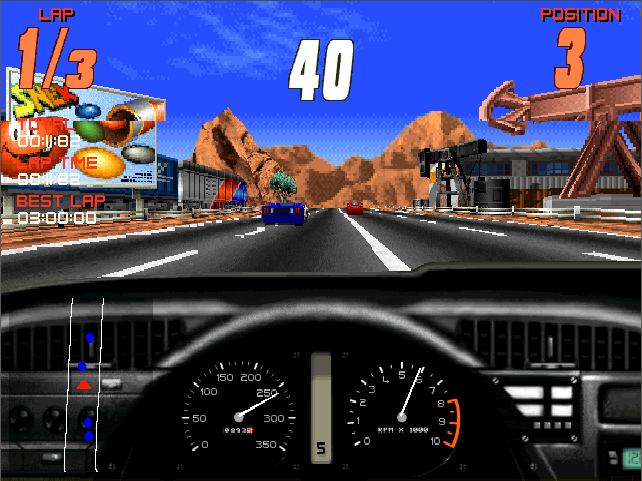 Given that it's an arcade racer, the damage model is non-existent and you have to accept the basic physics of the cars. If you bash an opponent they will appear to go sideways but then recover fully a second later with seemingly no loss of speed. If you hit a corner too hard you will roll your car, but this is quickly recoverable - think of it more as taking a 2 or 3 second penalty.
Given that it's an arcade racer, the damage model is non-existent and you have to accept the basic physics of the cars. If you bash an opponent they will appear to go sideways but then recover fully a second later with seemingly no loss of speed. If you hit a corner too hard you will roll your car, but this is quickly recoverable - think of it more as taking a 2 or 3 second penalty.
You will frequently hear the commentator verbally calling out updates on the race's events, such as 'Watch the next bend!', or 'You're in 1st place!'. This is a great touch and helps with the general absorption into the game.
Screamer runs in the now somewhat lacklustre 320 x 200 in 256 colours, but it's so very colourful and detailed - this game's still a beauty. There are minor glitches every so often, and the limited draw distance is occasionally noticeable. The tracks are fun and nicely detailed. There are four views you can select from at any time while racing using the F1 through F4 keys. These provide what I call 'bonnet view' (no dashboard), 'in-car view' (behind the wheel with the dashboard), 'close third person', and 'a bit further third person'.
Finally there is a multiplayer mode which supports racing up to eight human players over an IPX/SPX network. One of the human players is randomly selected from those who joined to pick a track, and then it's race time! Sadly there's no dial-up modem support.
Sound: Sound card support is decent: Sound Blaster/Pro/16, Gravis UltraSound, and ProAudio Spectrum. The menu music is upbeat and the in-game sounds are incredible and atmospheric. You hear all the cars around you as and when they are close. The commentary really adds to the feel and style of the game - nice job! 9/10
Gameplay: Screamer succeeds in its goals 100% - to be a Ridge Racer-style arcade game. The variety of options is good with six beautiful performance cars and enough circuits to keep you interested for a while. Where I feel the game is lacking is that it's almost too arcady - the AI cars are always bunched together too much, you cannot push one of them far behind by causing them to spin as they recover in literally about 1 second. This means you'll go from 1st place to 6th in the blink of an eye, then you can be back in 1st again 10 seconds later, which is a bit false. Furthermore, braking will often cause your car to seriously lose control unless you provide lots of very light brake commands, but then the competition seem to not require the same amount of braking as you. Still, the gameplay is not difficult (even on Pro level you won't finish last after a bit of practice). It runs super-fast even on fairly modest hardware, and if not you do have some options to cut the detail level down from High, to Medium, to Low. 7/10
Lastability: The multiplayer mode is excellent, though there's no dial-up/modem support so you must all be on the same local network. The game comes with a good variety of cars and tracks, though the simplicity of the game might underwhelm you after an hour or so. 7/10
OVERALL: 7.5/10
So there we have it for 1993 - 1995. I'm sure you'll agree the quality of the graphics have taken a huge leap forward in this time period. How did these games stack up?
|
|
|
|
|
|
|
Some seriously top-notch titles for the mid-90s, with Papyrus taking two of the three podium positions. NASCAR Racing and IndyCar Racing 2 are both amazingly detailed and support the higher resolution of 640 x 480 in 256 colours. The Need for Speed brought back racing while evading cops, and the original IndyCar Racing is just a lap behind these, given it's a slightly older game with the 320 x 200 resolution. A bunch of fun arcade-like games take 5th through 7th place, with the excellent Destruction Derby, Hi-Octane, and Screamer.
In the middle of the pack we have Domark's Formula One and Network Q RAC Rally.
Bringing up the rear in this timeframe are the two from Gremlin: Lotus: The Ultimate Challenge and the woeful Nigel Mansell's World Championship Racing.
The fourth and final part of our journey awaits you!






